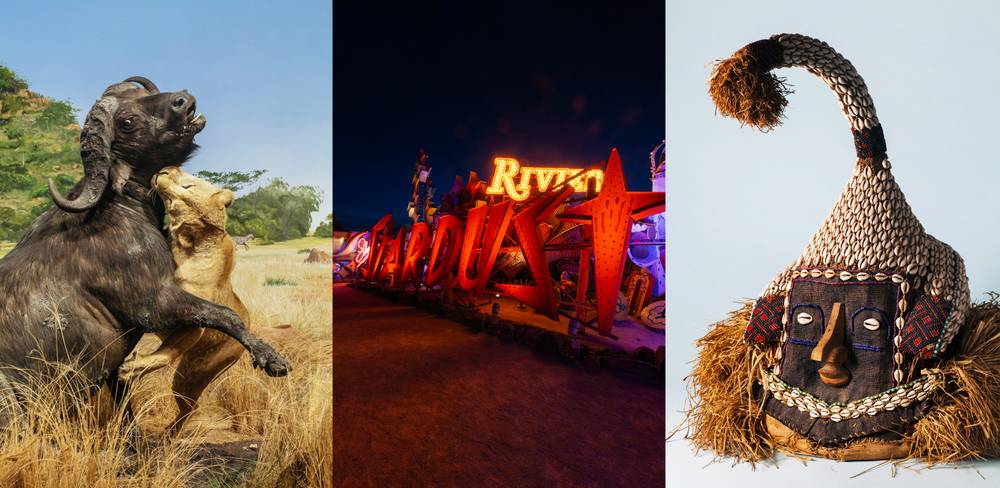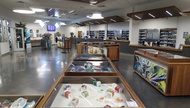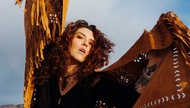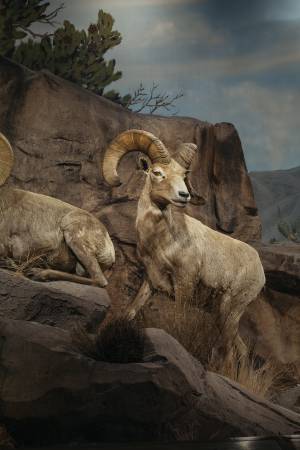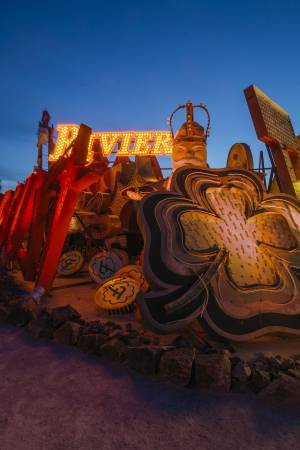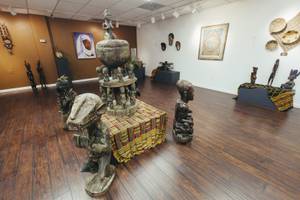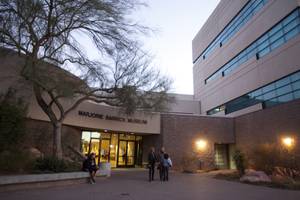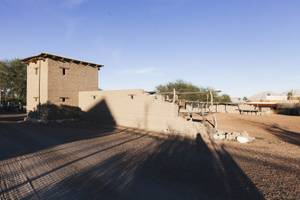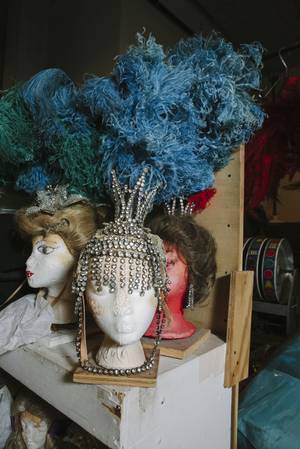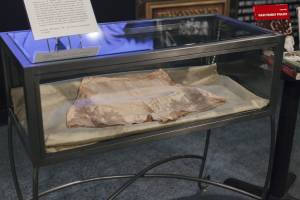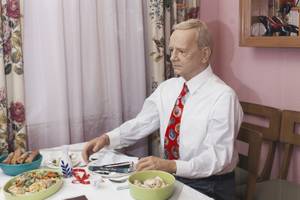Boom towns, bust towns, ghost towns and billion-dollar faux landmarks. Nothing is like Southern Nevada. Pioneers, showgirls, casino moguls, mobsters, architects and circus acts landing here in the wake of Mormon settlers and railroads have altered the landscape decade by decade, building out a community famously transient and filled with colorful stories. The artifacts left behind—from ginormous marquees to geiger counters—live in museums across the Valley.
But only in the past dozen years has a seismic cultural shift shaken the area, launching forth the Mob Museum, Neon Museum, Springs Preserve and National Atomic Testing Museum. The Erotic Heritage Museum arrived, as did the Burlesque Hall of Fame. The high-profile and mostly well-funded projects elevated the scene to a new level, creating a sudden critical mass.
Quirky or serious, in state-of-the art facilities or low-budget operations bordering on kitsch, museums tell the incomparable story of this place. But it’s hard to sell small-time dioramas when mega-casinos build themed cities and spend millions marketing them. And as museum expert Mark Hall-Patton points out, for every new resident, that’s another person who doesn’t know these resources exist. “What people don’t remember about Las Vegas is that we’re a new town,” says the Pawn Stars celebrity and museum administrator for Clark County. “We’re still a puppy with big feet. We’re still growing into our size.”
As are the museums. The Mob Museum shows what $40 million and a push from city leaders can do, while volunteers have maintained and slowly built smaller venues. Either way, “No other institution in society teaches using the real thing,” Hall-Patton says, “and that’s the one thing that will keep us relevant in the future.”
To that we say, here’s a sliver of a guide to go crazy over—with more than 20 museums and collections out there educating and inspiring, we had to pare it down.
LAS VEGAS NATURAL HISTORY MUSEUM
Nothing says “natural history museum” like boarding an elevator in a dinosaur enclave and exiting into a life-size diorama of early man.
Opened in 1991 to house a wildlife collection and prehistoric display, this Smithsonian affiliate in the Cultural Corridor has been triumphant despite its limited space. Founding director Marilyn Gillespie’s familiar description of growth challenges as “dinosaurs with an 11-foot ceiling” hasn’t stopped the accredited museum from being field-trip central for more than two decades.
Bighorn sheep climb mountainous crags in the Nevada Wildlife Gallery, where snakes burrow in the ground under native brush. Taxidermied predators roam the Serengeti against wall-to-wall, floor-to-ceiling murals in the African Savanna exhibit. And the prehistoric gallery is soundtracked by the roars of 35-foot-long, animatronic Tyrannosaurus rex—the kid-magnet of natural history.
The Strip’s habit of fabricating historical icons sneaks in. Treasures of Egypt, donated by the Luxor when the casino toned down its theme, has King Tut’s golden sarcophagus transporting you inside the ancient teen ruler’s burial chamber. 900 Las Vegas Blvd. N., 702-384-3466.
HOWARD W. CANNON AVIATION MUSEUM
The 1958 Cessna 172 with the old Hacienda logo painted on it and the cherry-red ’56 Ford Thunderbird convertible mark the Aviation Museum inside McCarran International Airport. Dedicated to the history of Southern Nevada Aviation, this second-floor installation overlooking baggage claim is the highest-trafficked museum in the Valley (even if travelers don’t realize they’re patrons). Why the Thunderbird? It’s an exact duplicate of the one used as a “crash wagon” at Alamo Airport, which later became McCarran. McCarran International Airport.
NEON MUSEUM
It’s hard to believe that the Neon Museum, home to the atomic Stardust letters and script of the white Moulin Rouge signs, only officially opened to the public in 2012 with guided daily tours. It’s been part of Las Vegas for decades, growing from a Yesco storage lot to a large boneyard appearing in movies like Mars Attacks!, TV shows and magazine fashion spreads, always racing to keep up with the implosions and raising funds for costly rescues.
A favorite among locals and tourists, the outdoor collection of more than 100 signs representing the stylish history of Las Vegas continues to awe. Large and sculptural, worn and restored, they once famously fronted elegant casinos or small businesses within the community and tower above the corridors they create.
Tours head out from the entrance—the relocated La Concha Motel lobby, designed by architect Paul Revere Williams and built on Las Vegas Boulevard in 1961—embarking on a well-scripted journey of Las Vegas past and present. 770 Las Vegas Blvd. N., 702-387-6366.
LEFT OF CENTER ART GALLERY’S MUSEUM COLLECTION OF AFRICAN ART
An a-Mantsho-na-Tshol mask from the Baga in Guinea and a Kakungu mask from the Suku in Congo are displayed here, among others used in ceremonies by various tribes. Carved wood adorned with cowrie shells, paint, raffia, hair and fabric, they demonstrate their influence in modern art. And a wooden wedding bowl from Tanzania’s Makonde, a cloth from the Ashanti in Ghana and Swaziland baskets tell the stories behind the handcrafted works.
“With African art you really start to see the humanity of the cultures,” says Left of Center Art Gallery administrator Mary Lou Evans, after explaining the role of a large wooden bowl set outside a family’s home and filled with community offerings in times of need. As local collector Joseph Walker says in a video documentary playing inside LOC, “the art is only coincidental.”
It was a big moment when a representative from the American Alliance of Museums paid a visit to the North Las Vegas nonprofit last summer to look at its African art and artifacts and advise it on seeking museum status.
The rich display of African masks, sculptures, figures, objects, instruments and cloths began decades ago when LOC founder Vicki Richardson began collecting while living on a teacher’s salary. It expanded when she met her husband, who’d lived in Sierra Leone. After putting their private collection on public display, LOC received others from local collectors Walker and Calvin B. Jones. 2207 W. Gowan Road, 702-647-7378.
DISCOVERY CHILDREN’S MUSEUM
After 23 years in the Cultural Corridor, the Discovery Children’s Museum moved to a new $50 million facility at Downtown’s Symphony Park in 2013, offering visitors 58,000 square feet of educational family fun. The high-tech interactive exhibits and themed activities based on science and social skills include a medieval castle; a three-story exploration tower about machinery, light and sound; a hurricane simulator and a very splashy physics exhibit about water. Eco City introduces kids to how cities function, and Young at Art teaches the foundations of visual art. 360 Promenade Place, 702-382-3445.
MOB MUSEUM
Spending less than three hours on your first trip to the Mob Museum is way too breezy for this collection so fascinating and vast it fills three floors of the former Downtown courthouse and post office built in 1933.
It opened on Valentine’s Day 2012, completing a longtime dream of former Mayor Oscar Goodman, and preceded by controversy over funding and concerns that it would glamorize violent criminals. But it has proven a rich and dynamic educational institution. The second-floor courtroom used for the Kefauver Committee hearings aimed at exposing organized crime sits in situ, anchoring the collection of once-classified documents, photographs and artifacts illustrating the rift between law enforcement and crime.
The museum houses the actual wall from the St. Valentine’s Day Massacre, still bloodstained and bullet-ridden. A police lineup, an electric chair and a gun-wielding simulation are among the interactive exhibits. Officially titled the National Museum of Organized Crime and Law Enforcement, the Mob Museum’s assets are storied, creatively brought together by Dennis Barrie, known for his work on the International Spy Museum and the Rock and Roll Hall of Fame. 300 E. Stewart Ave., 702-229-2734.
BARRICK MUSEUM
What started as UNLV’s original gymnasium (its old Beauregard mascot still sealed to the wooden floor) became the home of the Barrick Museum in the late 1970s, when Barrick was a natural history museum with a focus on pre-Columbian and Native American art and artifacts. In 2012, it became an art museum when it reopened as part of the College of Fine Arts with an exhibit of works from the closed Las Vegas Art Museum’s private collection.
Since then exhibits have shown everything from the commanding 3D presence of John Millei’s abstract paintings to the vibrant and intense recombinations of Break Ups and Tear Downs by Las Vegas artists Wendy Kveck and JK Russ and former Las Vegas resident Erin Stellmon.
The museum houses a healthy permanent collection, along with the LVAM works and the Herbert and Dorothy Vogel Collection. Its Inner Gallery is currently showing Ellsworth Kelly, with print editions by the artist who died last year at 92—an up-close look at the contemporary master’s understanding of color and angles. UNLV campus, 702-895-3381.
OLD LAS VEGAS MORMON FORT STATE HISTORIC PARK
Standing in the tidy historic site with Las Vegas Boulevard traffic on the other side of the fence, visitors are simultaneously in the past and present. In 1855 Mormon missionaries settled here, building a 150-square-foot adobe fort along Las Vegas Creek before abandoning it to farm. Some of the original walls still stand.
The site later became a ranch owned by Helen J. Stewart, a famed pioneer who raised five children alone and became the largest landowner in the county. Her reconstructed house seals you in another era. 500 E. Washington Ave., 702-486-3511.
BURLESQUE HALL OF FAME MUSEUM
From pasties, panties and delicately beaded and sequined costumes to a timeline of the art form’s femme fatales, the goods on display are juicy indeed. Founded by former dancer Jennie Lee (who also founded the Exotic Dancers League) in the ’60s and moved to Las Vegas from Helendale, California, in 2006, the museum has burlesque star Dixie Evans at the helm of its annual weekend celebration, which brings thousands from around the world for performances and workshops.
In 2010 the burlesque trove moved into Emergency Arts, a pocket space just off the Beat Coffeehouse. More than $32,000 raised on a recent Indiegogo brought in 65 percent of its fundraising goal for a new home opening this fall. 520 Fremont St.
NEVADA STATE MUSEUM
From showgirl artifacts in a shimmering wall to bones, miners and native life, this museum has it covered.
Long operating out of a Lorenzi Park building, the accredited museum reopened at the Springs Preserve in 2011, a move into a $51.5 million facility that effected a transformation. It tells the story of Nevada through interactive exhibits and a wealth of artifacts, from ancient fossils to the trappings of atomic testing and gaming. You can even learn about wildlife indigenous to the Strip.
A gallery has featured rotating exhibits including the history of modern-day communication, Mexican embroidery and Nevada-inspired contemporary art. And the museum’s recent acquisitions include the entire wardrobe collection from the now-closed showgirl spectacular Folies Bergere. 309 S. Valley View Blvd., 702-486-5205.
EROTIC HERITAGE MUSEUM
Most people will live their entire lives not expecting to see a pair of panties once belonging to Hitler’s companion Eva Braun, but the large lingerie is front and center in Sex in the Third Reich, an exhibit providing a tiny glimpse into the sexual climate and politics between World Wars I and II, explaining at the outset its use of offensive symbolism to display how iconography is used to control and brainwash societies. Located near a Chicken Ranch brothel exhibit, it links in a hyper-niche of human sexuality and leads into two floors on sex’s role in politics, religion, law and popular culture (complete with a sexualized Star Wars display with a naughty Stormtrooper standing near a Landspeeder).
Opened in 2008 by San Francisco-based Exodus Trust, the museum temporarily closed in 2014. Property owner Harry Mohney has since reopened the museum as a for-profit, and it’s now home to the show Puppetry of the Penis, as well as mammalian penis bones, the prop-heavy history of peep shows, video porn through the decades and artifacts ranging from a metal chastity belt to re-created porn-star vaginas. 3275 S. Industrial Road, 702-794-4000.
ATOMIC TESTING MUSEUM
Dioramas of Cold War America take us inside a family fallout shelter and a government office in a classified world, showing midcentury realities of nuclear fear. Starting out as a small collection in a room off the library at the Department of Energy on Losee Road, this national archive of Nevada’s relationship with nuclear testing is a Smithsonian-affiliated institution.
Its 8,000 square feet show the havoc atomic warfare wreaked on Japan while becoming a pop-culture focus in America—particularly in Nevada, where bars celebrated the theme and people watched test-blasts in the desert. Told through more than 12,000 artifacts, the story includes videos, documents and displays, from geiger counters to a simulated atomic blast that will tell you “duck and cover” would never have worked. 755 E. Flamingo Road, 702-794-5151.
CLARK COUNTY MUSEUM
Homes of early Las Vegas have taken over Heritage Street at the Clark County Museum, where relocated historic buildings make up the quaint neighborhood. The giant open-air diorama on a gravel road leads to a ’60s-era Gothic-revival wedding chapel that once sat next to the Riviera. Sidewalks under the canopies of mature trees take visitors into a 1935 Tudor revival built originally on Downtown’s Seventh Street, and a restored 1912 California bungalow featuring a vast front porch with rocking chairs. A three-bedroom Townsite Home, one of many famous temporary homes built to accommodate workers of the Basic Magnesium Plant, includes an exhibit about Southern Nevada’s role in the Second World War.
The experience is Memory Lane-esque, even for those whose knowledge of early 20th-century America was handed down by popular culture. Among the painstakingly decorated interiors is a 1930s Las Vegas motor-court cabin paired with a 1948 silver Spartanette trailer, the Candlelight Wedding Chapel, a railroad depot and a print shop, some inhabited by mannequins.
The small ghost town and walking trail take visitors back another century with structures and artifacts. And inside the museum’s exhibit hall sits a diorama-to-diorama narrative of the area, starting with the Ice Age and dipping into gaming, mining, wildlife and native cultures. 1830 S. Boulder Highway, 702-455-7955.
HISPANIC MUSEUM
Founded in 1991, the long-nomadic Hispanic Museum of Nevada settled into its home at the Boulevard Mall in 2012, mounting exhibits of religious iconography, artworks, textiles and artifacts representing Latin American and Caribbean cultures in what was once a store. It also sells work by Las Vegas artists. 3680 S. Maryland Parkway, 702-773-2203.
BOULDER CITY/HOOVER DAM MUSEUM
Located in the Boulder Dam Hotel in Boulder City’s historic district, this detailed narration of the Boulder Dam Project—a monumental feat in the 1930s that became the Hoover Dam—shows how laborers worked and lived in the government town that grew into quaint Boulder City.
The Hoover Dam, a museum in itself with outdoor displays of its construction, remains a main attraction at the edge of town, and the Nevada State Railroad Museum at 602 Yucca Street offers train rides on rails built by the Union Pacific Railroad in the 1930s, with locomotives on display. 1305 Arizona St., 702-294-1988.
